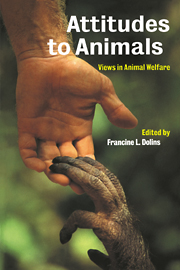Book contents
- Frontmatter
- Contents
- List of contributors
- Acknowledgements
- Part I Attitudes to animals
- Part II Animal awareness
- 4 The problem of animal subjectivity and its consequences for the scientific measurement of animal suffering
- 5 Environmental enrichment and impoverishment: neurophysiological effects
- 6 The behavioural requirements of farm animals for psychological well-being and survival
- 7 Personality and the happiness of the chimpanzee
- 8 Primate cognition: evidence for the ethical treatment of primates
- Part III Animal welfare
- Part IV Research and education
- Part V Epilogue: the future of wild animals
- Index
5 - Environmental enrichment and impoverishment: neurophysiological effects
Published online by Cambridge University Press: 16 November 2009
- Frontmatter
- Contents
- List of contributors
- Acknowledgements
- Part I Attitudes to animals
- Part II Animal awareness
- 4 The problem of animal subjectivity and its consequences for the scientific measurement of animal suffering
- 5 Environmental enrichment and impoverishment: neurophysiological effects
- 6 The behavioural requirements of farm animals for psychological well-being and survival
- 7 Personality and the happiness of the chimpanzee
- 8 Primate cognition: evidence for the ethical treatment of primates
- Part III Animal welfare
- Part IV Research and education
- Part V Epilogue: the future of wild animals
- Index
Summary
The idea that the degree of complexity in an animal's environment may cause neurophysiological changes is not a new one. Nor, indeed, is the idea that performance of certain learning and memory tasks by an individual might, in some way, ‘exercise’ particular regions of the brain and that this ‘exercise’ might lead to changes in size or capacity of those brain regions. Most of us at some time have probably wished that our intellectual power could be enhanced by mind exercises in a way not too dissimilar from going jogging or working out in a gym. Equally, we might worry that failure to exercise our intellect might lead to it growing flabby and atrophying. Evidence does exist that the complexity of our environment has a strong effect on the development and maintenance of cortical connections. For most animals, the laboratory environment is usually far simpler and less stimulating than their natural environment would be. This sensory impoverishment may have a significantly detrimental effect on an animal's brain organization, particularly during its development. The aim of this chapter is to survey what is known of the effects of environmental complexity on neurophysiological development and to determine the key elements of the environment important for normal development.
The first experiments testing the neurophysiological effects of environmental conditions were done over 300 years ago. By the middle of this century, increased knowledge of brain development had resulted in a firm belief that brain size did not change in response to experience: the size and structure of the adult brain was purely and simply a product of development and developmental processes were genetically fixed.
- Type
- Chapter
- Information
- Attitudes to AnimalsViews in Animal Welfare, pp. 54 - 76Publisher: Cambridge University PressPrint publication year: 1999
- 5
- Cited by



